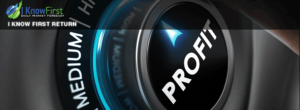I Know First Sample Portfolio Returns 60.66% in 2013 (1-month predictions)

Click on the links below to view the predictions and returns for those dates: January 1 2013, February 1 2013, March 1 2013, April 1 2013, May 1 2013, June 1 2013, July 1 2013, August 1st 2013, September 1 2013, October 1st 2013, November 1st 2013, December 1st 2013 Above are the returns from I Know First’s Top 10 Stocks and S&P 500 portfolio that were sent to I Know First subscribers. If an investor had bought all of I Know First’s 1-month, top 10 stock predictions in equal weights on the first day of each month starting on January 1st 2013, he would have earned 60.66%, beating the S&P 500 by 31.27%. This portfolio perfectly illustrates the benefits of the algorithm for inactive investors that are applying a buy-and-hold strategy and looking for long-term appreciation. Even though we advise checking the forecasts daily to identify trends in the algorithm, sometimes it may be better to rely on the learning abilities of the system, as the algorithm is self-learning, and thus live. The resulting formula is constantly evolving, as new data is added each day. For instance, the algorithm began predicting Alcatel-Lucent’s (ALU) rise as early as December 9th 2012 resulting in an actual return of 10.22% from January 1st 2013 to February 1st 2013. Then the algorithm continued to rank ALU consistently in the top 10 stock picks with the strongest signal fit for long position for the following six months even though the actual 1-month returns in February and March were negative, reaching -15.06% and -3.65% respectively. At this time, retail investors that held the stock since the initial prediction may have doubted the algorithm’s efficiency. However, a professional investor would have seen this as the perfect opportunity to buy more ALU stocks at a discounted price. Even while the stock price was declined, the algorithm’s prediction of ALU was consistent and continued considering ALU as one of the best fit for a long position for 1-month holding period. ALU gained 2.26% in April 2013, 22.63% in May 2013 and ultimately resulted in an accumulated return of 118.42% since the initial “buy” signal (December 9th 2012- April 1st 2014). In one year, from December 9th 2012 until December 9th 2013, ALU returned an astonishing 315.45%. In addition to stock recommendations, the algorithm predicts the direction of the S&P 500 as well. In order to compare I Know First’s portfolio performance with the S&P 500, investors must consider the risk-adjusted returns to see if they are being adequately compensated for the risk they are assuming. The goal is to achieve the largest return per unit of risk. The Sharpe ratio measures this risk/return relationship, and is often used to evaluate the performance of a portfolio. The formula for the Sharpe ratio is:  E(rp) is the average return of I Know First portfolio σ(rp) is the standard deviation of the portfolio rf is the best available rate of return of a risk-free security (i.e. T-Bills). We will consider it equal to zero since it is very low. Therefore, over the one-year period, I Know First’s Portfolio Sharpe ratio is 1.12 while the S&P 500 has a Sharpe ratio of 0.93. Based on these calculations; I Know First was able to generate a higher return on a risk-adjusted basis. A difference of 0.19 is a solid indicator of why using an algorithmic trading strategy is better than the S&P 500 in terms of risk and return. Since diversification reduces volatility, and the S&P 500 and I Know First portfolio constitute as diversified portfolios, their standard deviations are quite similar. Furthermore, historical performance does guarantee future results. While choosing the investment with the highest Sharpe ratio is logical, diversification and risk aversion should be considered as well. Missed the latest trend? Looking for the next rising stock? Find out todays stock picks based on our advanced self-learning algorithm.
E(rp) is the average return of I Know First portfolio σ(rp) is the standard deviation of the portfolio rf is the best available rate of return of a risk-free security (i.e. T-Bills). We will consider it equal to zero since it is very low. Therefore, over the one-year period, I Know First’s Portfolio Sharpe ratio is 1.12 while the S&P 500 has a Sharpe ratio of 0.93. Based on these calculations; I Know First was able to generate a higher return on a risk-adjusted basis. A difference of 0.19 is a solid indicator of why using an algorithmic trading strategy is better than the S&P 500 in terms of risk and return. Since diversification reduces volatility, and the S&P 500 and I Know First portfolio constitute as diversified portfolios, their standard deviations are quite similar. Furthermore, historical performance does guarantee future results. While choosing the investment with the highest Sharpe ratio is logical, diversification and risk aversion should be considered as well. Missed the latest trend? Looking for the next rising stock? Find out todays stock picks based on our advanced self-learning algorithm.  Before making any trading decisions, consult the latest forecast as the algorithm constantly updates predictions daily. While the algorithm can be used for intra-day trading the predictability tends to become stronger with forecasts over longer time-horizons such as the 1-month, 3-month and 1-year forecasts.
Before making any trading decisions, consult the latest forecast as the algorithm constantly updates predictions daily. While the algorithm can be used for intra-day trading the predictability tends to become stronger with forecasts over longer time-horizons such as the 1-month, 3-month and 1-year forecasts.












